Rapid Advancement: A truck for the future part 2
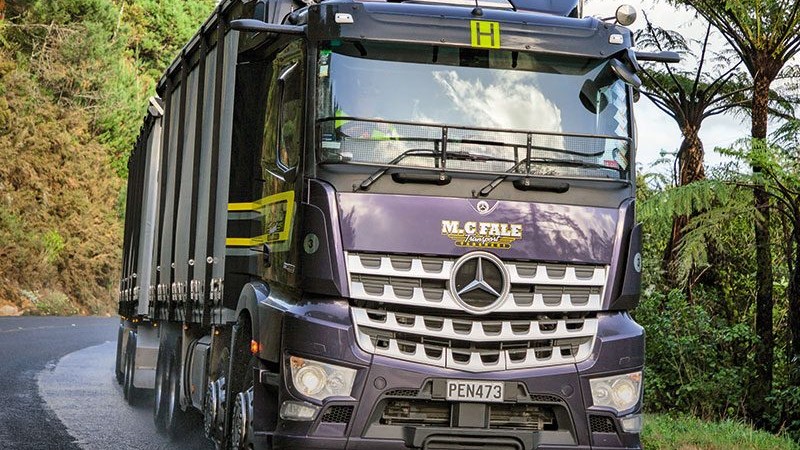
It’s been a fair while since New Zealand Trucking jumped aboard the latest generation of products with the three-pointed star in the grille. Yes, in April this year, we featured six of them, but that was entirely an exercise to explore Daimler Truck’s MirrorCam technology as thoroughly and fairly as possible. In fact, the last time we featured one in-depth was in the July 2019 issue, when we hopped aboard Carr & Haslam’s Arocs 3246 10-car transporter.
That was less than six months before the latest iteration of the Actros (MP5) and heavy-duty Arocs models were shown to New Zealand and almost a full Covid-delayed year before they officially hit the road. And with it all came the introduction of MirrorCam, the MultiMedia Cockpit, and a suite of advanced electronic safety systems. We’d have a lot to get to grips with during our time with the MC Fale team and with one mirrored Arocs 3258, and one mirrorless Arocs 3258 in the fleet lined up to run a similar route, there could be no better opportunity…
But that’s all to come. What about the Daimler group of trucks suits Mike’s business? Except for a DAF CF530, the MC Fale fleet has embraced Freightliner, Fuso and Mercedes-Benz.
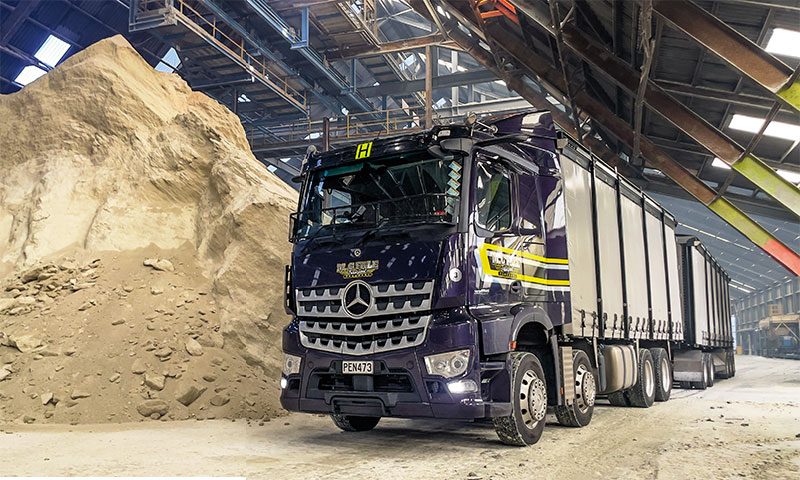
“There are a few reasons for that,” Mike begins, explaining the model lineage. “We had a Freightliner Coronado, which was a bit limited capacity-wise. We do a lot of ‘light’ bulky stuff, such as DDGs [Dried Distiller Grains], and we weren’t getting the loads in. So that was replaced with the first Arocs, which has run great. We also had an older Mitsubishi Shogun FV430, which we replaced with a 2019 Fuso HD470. That was one of the last before the latest generation Shogun came out, and it’s done 300,000km now.”
Naturally, as Mike developed his plan for the new curtainsider tipper, the new Arocs was an obvious candidate as the base. But he still had an American- sized itch that needed to be scratched, which he did just a few weeks before we arrived. “Ah, the Coronado 122 out front – that’s a good, tough truck. It’ll run part-time filling in the gaps,” Mike says. Those who notice it on the road may place it as the ex-Bill Hammond unit we featured on the cover of our October 2017 issue.
“Look, the first thing I considered when buying the new trucks was bringing things together. I thought the integration between all Daimler’s models was not a bad concept. German engineering, a bit of American muscle, and Japanese technology – it works for me that we’re not too much one way or the other, and it can also ease the transition between the trucks for the drivers.
“But, we will probably get to the stage where we’re just running Mercs.”
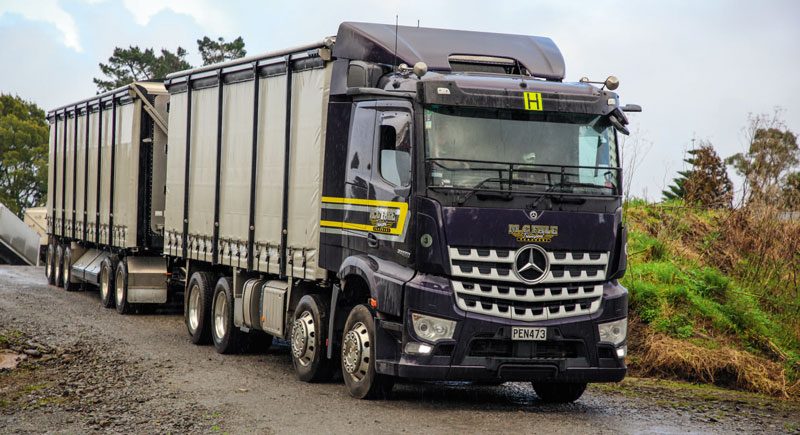
Older, but not old
Mike had a good run lined up for us to see the new unit in action. We had a quick preview the day before as we followed the trucks out to Ballance Agri-Nutrients, Kapuni, where they loaded up with urea before parking up overnight. An early morning start would see drivers John Langlands, Iain Parker and Scott Rowland in the Fuso all head north, with Iain and Scott running together up to Te Awamutu, from where John continued to Cambridge, then onto SH1 before heading in the direction of the Kaimais for Ballance Mount Maunganui. This gave us the fortunate opportunity to experience the two Arocs in succession, so we hopped aboard with Iain first to reacquaint ourselves with the more ‘old-school’ of the two.
At first glance, there’s not much old-school about Iain’s truck. It’s all of three years old, and with 207,000km under its wheels, it’s only just getting into its stride. The furthest Iain goes in the general southerly direction is Manawatu or Te Awamutu to the north. “Mike seems to find slots that suit horses for courses,” Iain comments. “And I’m more than happy with that.”
Iain’s bathtubs were loaded with 34.5 tonnes of urea. “We try to keep it under our 54-tonne permit, leave a bit of leeway for variations between weighbridges,” he comments.
Our only experience of Iain’s 3258 under load would be the southern side of Mt Messenger. As he wound the Arocs up the dark road, it pulled steadily, dropping down to 20kph at 1600rpm in sixth at the tightest pinch. The PowerShift transmission held seventh most of the way, moving up to ninth as Iain got his speed up to about 40kph approaching the summit.
“I do flick the transmission into power mode for climbing the hills,” he remarks, “and then drop it into manual for the downhill. Auto can let the revs operate too high for me.”
You might be hard-pressed to pick Iain’s Arocs as a previous-generation model. The instrument binnacle houses four crisp gauges in two pods that flank an LCD information screen, all classily backlit in white and blue. The dash wrap houses a touchscreen infotainment system that’s perhaps a bit smaller than one might expect in a modern truck. Below are easy-to-fathom climate controls and a bank of accessory and auxiliary switches. The profile of the A-pillars viewed straight ahead is narrow, and there’s a fair gap to the side before the mirror housing. But these are big, solid mirror units, and they do seem to cast quite the blind spot.
“You have to take an extra bit more time pulling out from a junction to make sure there’s no car you’ve missed blocked by the mirror housing,” Iain says.

Versatility in action
Our first opportunity to jump aboard the new Arocs with John was for his tip at Ballance Mt Maunganui. The day after our run, Mike received the truck’s 54-tonne HPMV permit, but up to that point, John was running at 50Max. His load of urea for the Mount weighed in at 27.2 tonne, split 12 on the truck and 15.2 on the trailer. The bump in payload was a no-brainer for Mike to get full use from the unit, as it has a relatively heavy tare of 22.7 tonne, the truck coming in at 13.48 tonnes and the trailer at 9.3. By comparison, Iain’s unit weighs in at 19 tonne, split 12.7 tonne and 6.3 tonne.
Placing a set of hydraulic rams under a flat-deck curtainsider will always come with a bit of compromise, deck length compared with a conventional bathtub tipper chief among them. At full tip of 51°, the 10.5m-long trailer body will reach 10.77m into the air, the 7.4m-long truck body 8.2m, so exactly where the unit is deployed to tip needs to be taken into consideration. The Ballance shed is sizeable, to say the least, so John has no issues here tipping the trailer. He then pulls forward, uncouples the trailer and backs up the truck to the designated bin. It’s a tight fit side to side, and there’s not much room to manoeuvre the truck into position. Getting it in requires a fair amount of steering wheel twirling and transmission wand flicking – and ultimate reliance on the MirrorCams. It’s here the distance markers on the screens come into their own – with the rear end of the truck clearly marked by the bottom blue line. It’s a case of ‘easy does it’ and ‘get out and double check’, but before long, John has the bin in the air for the tip.
Before we depart, there’s one more quirk of a tipping bulk curtainsider to be addressed, sweeping out the bits of bulk caught by the inner flaps of curtain. On the way out, John eases the big Arocs down a narrow ramp alongside an unnervingly close steel upright. Although he’s got his eyes fixed on the MirrorCam display watching the trailer, John again takes the opportunity to get out and check his clearance.
“We’ve probably got half a foot, but I don’t mind. It’s easier taking a minute instead of guessing and tearing your curtains. It would’ve been alright if I’d been in here before, but anything new I will get out and check,” he says, explaining that’s not a comment on the picture portrayed by the MirrorCam’s 15-inch screens. In fact, it matches the ambient lighting levels within the shed and remains sharp throughout.
From Ballance, John heads up the road to Contract Packaging and Storage. There, we have a demonstration of the unit in curtainsider mode. The Straitline Canvas curtains are unlatched and loosened on their ratchets and the poles are unclipped via simple thumb catches and slid to the side, before it’s all opened up to accept 26 tonnes of palleted product. The load is split 10 tonnes on the truck and 16 on trailer, bringing us in at 49 tonnes all up for the trip home.
“This unit really is awesome for versatility. We’ve done timber, bags of fert, bulk… as far out as Whangarei. It’s doing what it was designed to do, and I’m happy using it. The concept is good, the overall build is good,” John says.
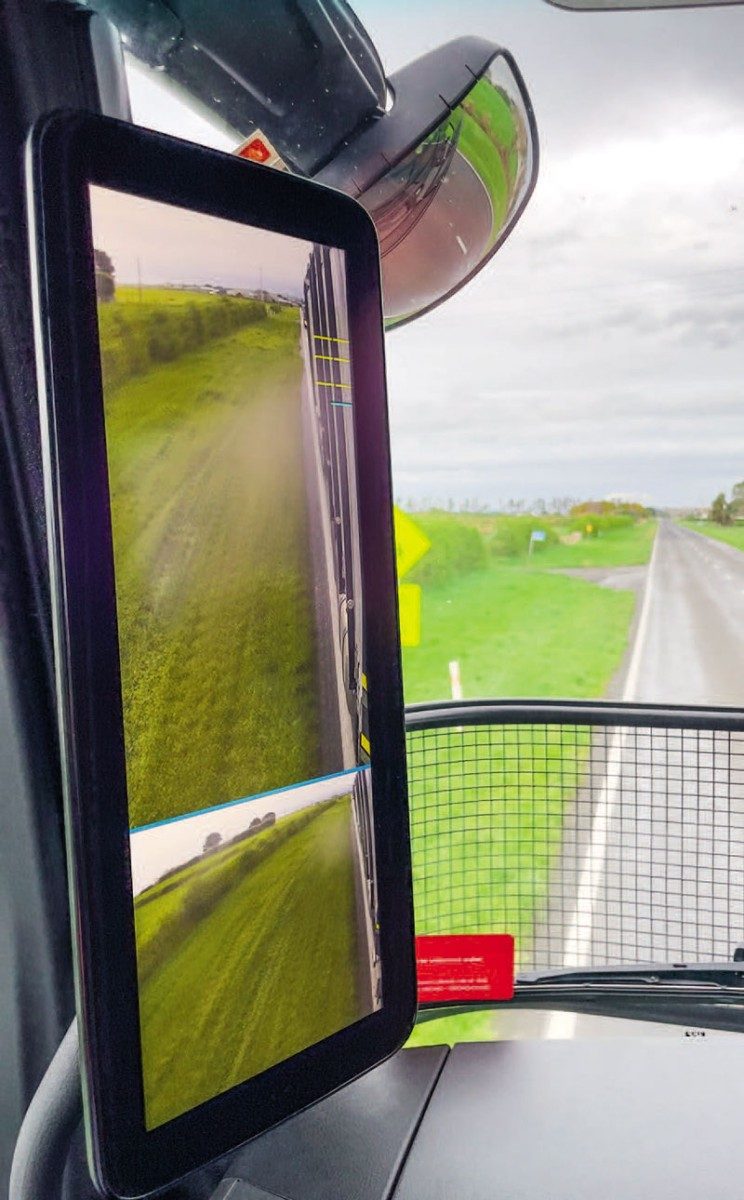
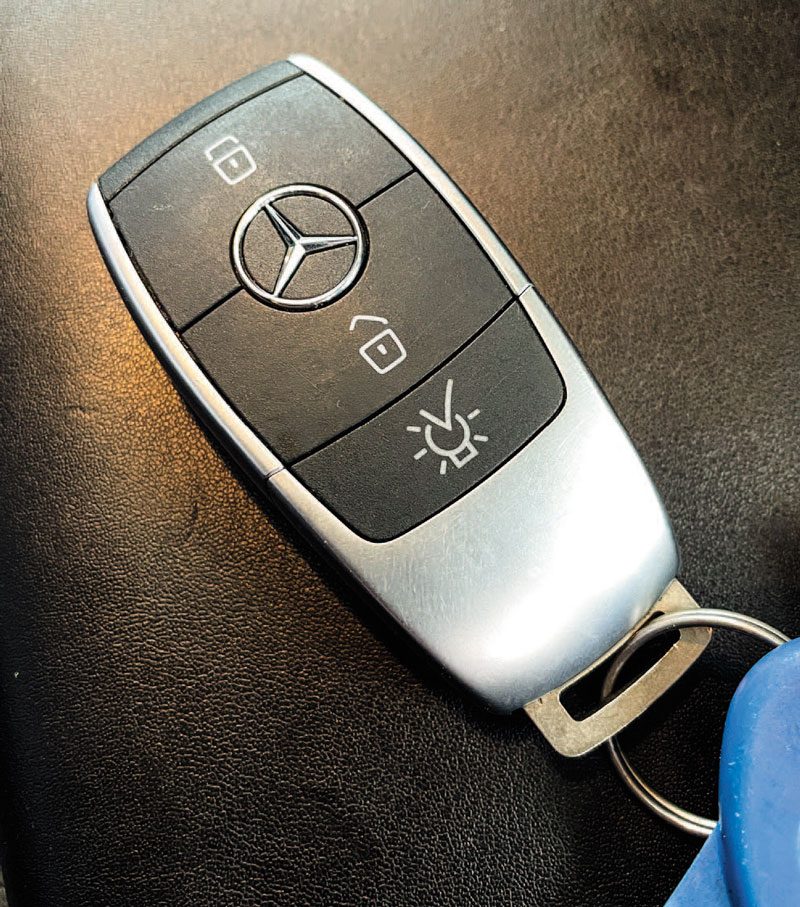
Bells and whistles
In the year John has been a part of Mike’s team, he piloted the DAF for six months, the Arocs Iain’s in now for four, and by the time we’d caught up with him, he’d been in the MirrorCam Arocs for two months and 12,200km.
If the cab appointments of the older Arocs might not initially come across as ‘previous-gen’, taking a seat in the latest iteration might be a shock to the system. Pared-back and minimalist is probably the best description of Mercedes-Benz’s MultiMedia Cockpit concept. Gone are the classy gauges and conventional switchgear we spoke of earlier, and in their place are two 12-inch customisable screens that, according to Mercedes-Benz, “present information in super- crisp detail, giving the driver more control and information in a clear and stylish manner”.
The driver’s ‘instrument’ screen presents speed and revs in two simple round gauges, with central numerical readout of speed in the speedo and gear selection in the rev counter. At the bottom of each gauge sit the fuel and DEF levels. Sharing the right-hand wheel spoke with the cruise control buttons is a touchpad with which the driver can select the information displayed in the area between the gauges.
Similarly, the left-hand wheel spoke houses audio and telephone buttons as well as a touchpad for controlling the centre touchscreen without having to lift a hand off the wheel. Mercedes- Benz has fitted hard buttons for temperature and volume adjustment, and shortcut buttons to call up climate control, navigation, phone and audio, as well as truck settings, information and auxiliaries such as the PTO.
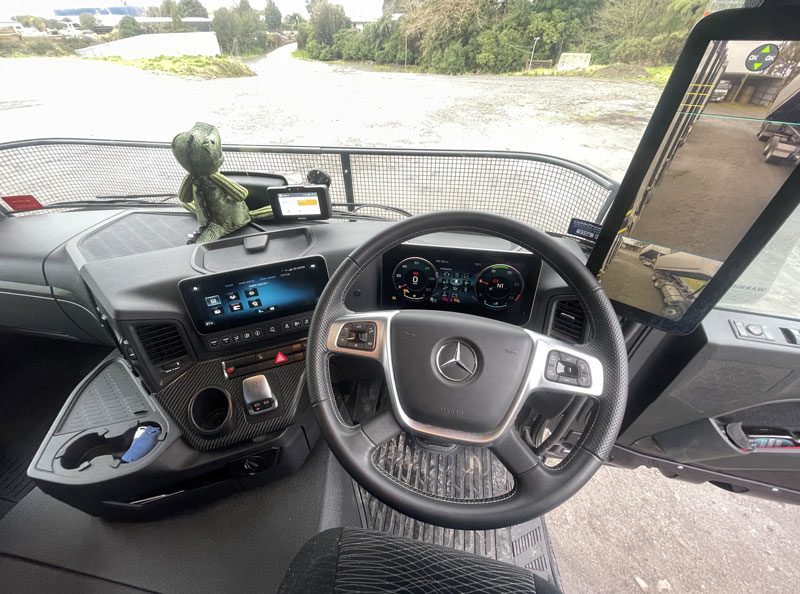

“Yeah, I acclimatised pretty quickly,” says John. “But touchscreen systems in general… I’d rather have the buttons. It can be a little tedious to find some functions, and you sort of have to commit to memory how to do certain things. You get used to it, it’s OK – and I haven’t been on the old one for a while, so I don’t know how I’d feel going back to it – but nothing beats old-fashioned buttons or dials where everything’s just there.”
One feature of the system John really likes is the truck-specific navigation. “You set the dimensions and weights of the unit, and it’ll give you a truer estimate of your times than normal GPS. I use it to keep track of my progress because it’s bang on. At most, something like mobile traffic lights could throw it out by around 10 minutes,” he says.
Right, so what about the big one – how does John get along with MirrorCam? “They’re awesome,” he answers almost before I can finish asking. “I was a bit hesitant, like most people would be, but I wouldn’t go back. Not when they’re so good on the motorway in peak Auckland traffic; you can see all the lanes around you, and the wide angle is great. You flick between the two [standard and wide-angle views], and you get a big picture of what’s around you. In Auckland driving especially, I’d have these over standard mirrors.”
One criticism of the system commonly noted in our April article was MirrorCam’s ability to adapt to rapidly changing light conditions. With the second generation now available in Europe, Mercedes-Benz is said to have addressed this. “Backing into a change of light is a bit of a problem, but at night you can’t fault them. They absorb all the light around, and the picture is a lot clearer than normal mirrors,” John says. “They generally stay clean, if you get a tailwind it can blow rain on them, but you’re only wiping off a tiny lens, not a full mirror. I love the cams.”
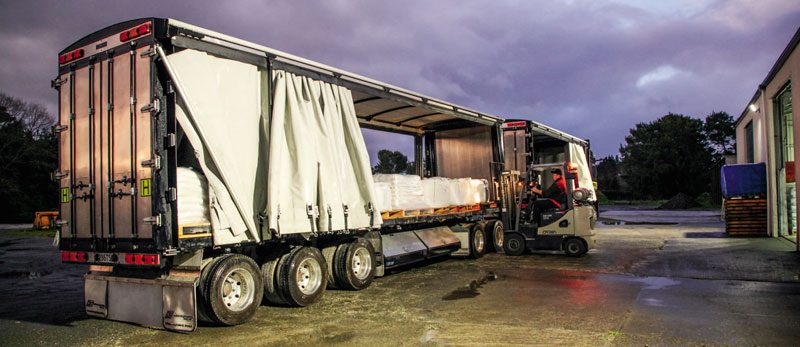
The notable difference in forward vision between Iain’s and John’s trucks is the absence of the physical mirror housing. The additional width at the A-pillar due to the placement of the screens truly is negligible once you realise how much the view is opened up with the deletion of conventional mirrors.
“I’ve come out of Inter 9800s and K200 Kenworths – the flashest thing they’ve got is a Bluetooth stereo,” John says with a laugh. “And you get out of this at the end of a 14-hour day, and you feel like you can do it again easily. One of those, and you’ll rather start again tomorrow.”
Comfort and performance
A comfortable truck is something of an asset these days. SH3, especially, is currently in a less-than-smooth condition. John doesn’t mince his words on the topic: “You know when you get back to Taranaki. The road is bad, piss poor. But in saying that, there’s been a shitload of rain this year.”
The Arocs was spec’d with the 2.3m-wide ClassicSpace Large Cab, which is mounted on steel spring suspension. The rear suspension is a Mercedes-Benz eight-bag air system, and John gets to perch on an air-suspended driver’s seat. Suffice to say, the ride’s perhaps not quite as plush as some Euro rivals, but it ain’t bad either.

Being a Classic Space L-Cab means a floor-to-ceiling height of 1590mm and 2.3m of cab depth, allowing for a 750mm-wide bed. “The truck is awesome overnight, the bunk is comfy-as,” John comments.
The meaty bits comprise of the Mercedes-Benz OM473, a 15.6-litre Euro-6 powerplant that puts out 431kW (580hp) at 1600rpm and 2800Nm (2065lb/ft) at 1100rpm. Drive goes through the OEM’s G330 12-speed PowerShift AMT with economy, standard, power and manual modes. While the mileage covered thus far could probably be considered negligible, the Arocs gets on well with a staunch bellow emanating from below the cab under load.
John had her sitting at 29kph in sixth at 1650rpm, climbing the Kaimais on our way into the Mount. On our way back to Stratford, the climb out of Te Kuiti was tackled at 31kph in seventh at 1750rpm, and the northern side of Mt Messenger at 35kph in eighth at 1450rpm. With a 3.583:1 rear end, the OM473 settles around 1300rpm at a steady 90kph. Currently, the Arocs is averaging 1.9km/l, which will no doubt improve as the mileage clocks up.
John comments that he’ll flick the transmission into eco mode on motorways, utilise the extra revs afforded by the power mode when climbing hills, and occasionally run it in manual if “it dicks around trying to find a gear”. Probably just the system learning…
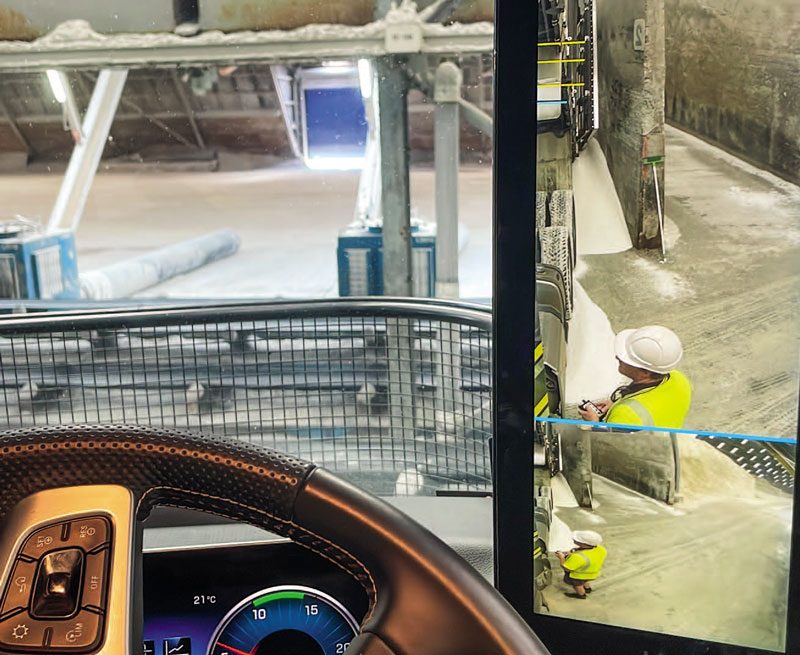

For descending hills, the Arocs is equipped with a three-stage Jacobs engine brake that offers up 480kW of holdback. John comments that it’ll run right to 2300rpm, and he’s found it can be a touch aggressive in stage three, grabbing gears. A neat touch with the digital tacho, though, is the appearance of an orange band in the optimum part of the rev range when the Jake is activated.
The Arocs is equipped with the full suite of Daimler Truck safety equipment. That’s the safety pack inclusive of stability control assist, proximity control assist, active brake assist 5, lane keeping assist and attention assist.
John says the systems can be a little oversensitive, sometimes picking up railings and marker pegs.
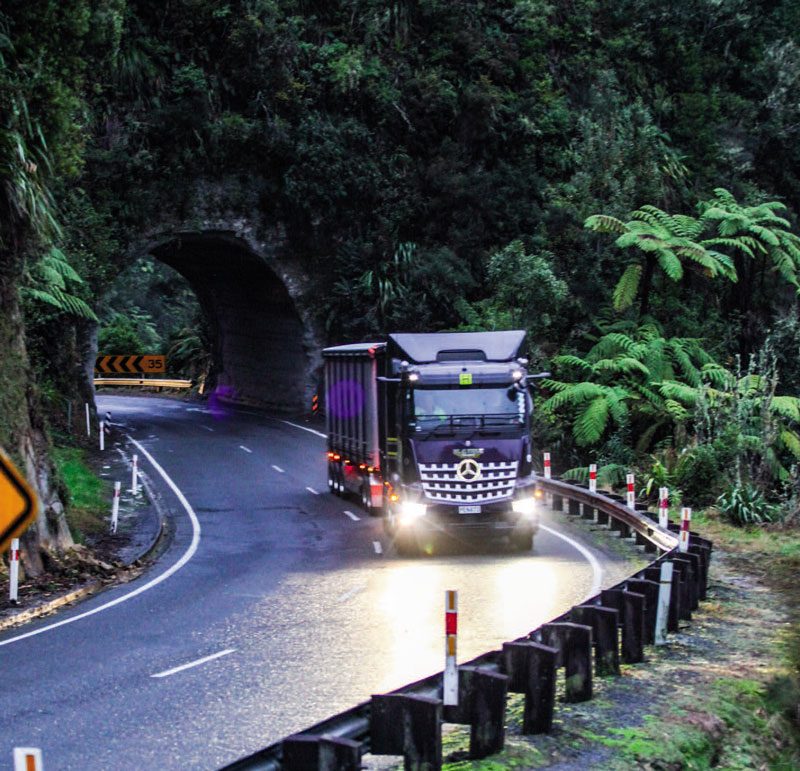
Doing it right
Mike Fale and his team at MC Fale Transport illustrate how a rapidly growing fledgling business can be done right. It proves the worth in being connected to the industry they serve, understanding their clients’ needs and respecting where they’re coming from. Mike’s respect for his team and approach to managing operations show, too, that limits don’t need to be pushed to get the job done and make a success of it. And finally, his journey shows the value in having the right tool for the job – and not being afraid to take a calculated risk to create that tool, partnering with the right minds to put it on the road.
“I am from a family that did not have a lot of money. I have had to work myself up to where we are now from pretty much a standstill start,” says Mike. “There certainly have been hiccups where I’ve wondered what I’m doing. I’ll never say it’s easy, but you need to take on the pressure and look at things with an open mind.
“It gets real busy, and it can be a real headache, but there have been plenty of days also where it’s been quite a blast to achieve all the tasks; when everything’s gone right, you’ve ticked all the boxes, your clients have paid their bills, and you can have a beer on a Friday!” Mike says with a laugh.
Doing it right? We’d say so.
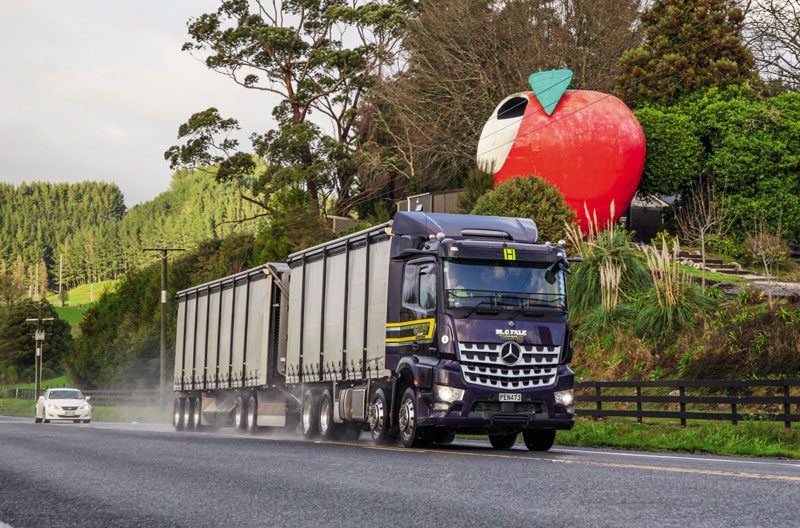
Special Thanks
Thanks to Mike and Sonia Fale, John Langlands, Iain Parker and Scott Rowland for having us along, telling us your stories, and sharing our enthusiasm for everything we needed to do to get the story.
Thanks to Russell Hotter for the insightful factory tour and your candid explanation of the trailer and body build process. You’re surely onto something!
Last but not least, thanks to Trevor McCallum at CablePrice Christchurch for your support and supplying the technical detail on the truck.

Read for Part 1
Quick reads from Test
Read more
Fast Food
0 Comments28 Minutes
A rock and a hard place
0 Comments44 Minutes
New home new suit
0 Comments45 Minutes
Of culture and longevity
0 Comments37 Minutes





















